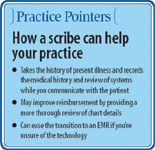Article
Need more time with patients? Consider hiring a scribe
I have found that one of the most effective ways to enhance the efficiency of my practice has been to hire a scribe. A scribe is a person who shadows a physician and takes notes either in the chart, or, better yet, on the computer, freeing the doctor to have more eyeball-to-eyeball contact with the patient.

The scribe interacts with a new patient after the doctor introduces himself to the patient. The scribe takes the history of present illness and records the medical history and review of systems. The scribe then presents the HPI to the physician and accompanies the physician into the room.
At this point, the doctor may ask a few additional questions or probe any aspects of the HPI that are not clear or need more in-depth questioning. The doctor conducts the physical exam and the scribe records the positive findings in the chart or the electronic medical record. At this juncture, the doctor can have a discussion with the patient regarding the diagnosis and the plan of management, and the scribe records the doctor's plan of action.

Do you need a scribe?
Before implementing a scribe in your practice, you must first decide if the need for one exists. If patients need to wait more than 4 to 6 weeks to make an appointment for a routine visit, then you have a backlog of patients that a scribe could help you reduce. If your last patient is scheduled at 4:00 or 4:30 and you aren't finished with patients until 5:30 or 6:00, then a scribe will help improve the efficiency of the practice. If the majority of your codes are level 3 or less, then you can improve your productivity by having a scribe. Finally, if you are considering a move to an EMR but are technophobic, then a scribe might provide a natural segue to implementing the EMR.
Pros, cons, and details
By using a scribe, you can focus on communicating with the patient instead of writing or using the computer. In my practice, using a scribe allows me to see five or six additional patients each full day in the office. Also, my coding has moved from the previous level 2 to 3, to level 4 to 5 because the scribe is more thorough in conducting the review of systems and medical history and recording the fine nuances of the physical exam that I often neglected to document, such as a neurologic and dermatologic examinations.
The disadvantages of having a scribe are cost, training time, and an adjustment to the change in what you've been doing for so long. The new system can be frustrating in the beginning, but when you see how efficient you become, you will enjoy the luxury of having a scribe. As a matter of fact, when the scribe is absent or on vacation and I have to use the computer, I realize how invaluable she is and how effective the technique is enhancing my practice.
Scribes can come from many different employment backgrounds. My first scribe was a college graduate in the gap year between college and medical school. She was taking courses to improve her MCAT scores and worked in my office for a year before entering medical school. Another worked as a transcriptionist who had been replaced by an EMR and wanted to stay in the medical field.





